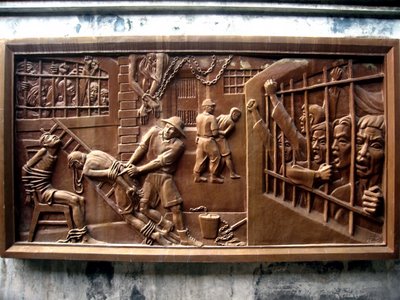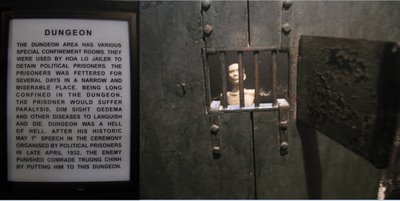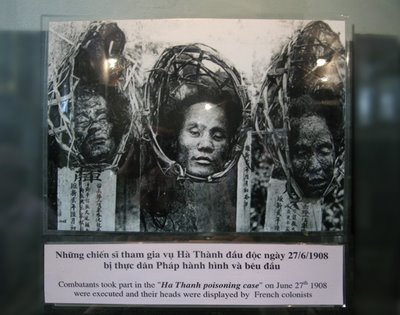 Every country has her own history of prosperity and poverty, joy and misery, war and peace. Vietnam is no different. In fact, this country has probably seen more than her fair share of war and political unrest in the past century. From the (First) Indochina War when the Vietnamese nationalists (Viet Minh) battled against the French for independance (1946 - 1954) to the American Resistance War (1959 - 1975) when Vietnam became the battlefield for various foreign powers, including America and the USSR; the people of Vietnam have seen their motherland ravaged by both colonial and nationalistic forces. And no other place in Hanoi has been more of a witness to the atrocities of war than Hoa Lo Prison.
Every country has her own history of prosperity and poverty, joy and misery, war and peace. Vietnam is no different. In fact, this country has probably seen more than her fair share of war and political unrest in the past century. From the (First) Indochina War when the Vietnamese nationalists (Viet Minh) battled against the French for independance (1946 - 1954) to the American Resistance War (1959 - 1975) when Vietnam became the battlefield for various foreign powers, including America and the USSR; the people of Vietnam have seen their motherland ravaged by both colonial and nationalistic forces. And no other place in Hanoi has been more of a witness to the atrocities of war than Hoa Lo Prison. Built in 1896 by the French as their Maison Centrale or prison, the original sprawling complex was used to hold Vietnamese political prisoners where they were often subjected to brutal torture, mental anguish, brainwashing and eventually, execution.
Built in 1896 by the French as their Maison Centrale or prison, the original sprawling complex was used to hold Vietnamese political prisoners where they were often subjected to brutal torture, mental anguish, brainwashing and eventually, execution.
When the Viet Minh wrestled independance from the French, the prison was renamed Hoa Lo (meaning fiery furnace) and used by the revolutionaries to incarcerate rebels and just about anyone who dared to defy their orders.
 Now, only a small part of the original prison complex remains because a big portion of the property has been torn down and in its place now stands a modern highrise. The huge wooden front door with the words "Maison Centrale" in large letters etched onto its grand arch still stands, serving as the main entrance to what is now Hoa Lo Prison Museum.
Now, only a small part of the original prison complex remains because a big portion of the property has been torn down and in its place now stands a modern highrise. The huge wooden front door with the words "Maison Centrale" in large letters etched onto its grand arch still stands, serving as the main entrance to what is now Hoa Lo Prison Museum. There are a lot of prison artifacts on display like the type uniforms the inmates wore, their meal bowls and utensils, shoes, even a radio. One particularly odd item was a terracotta lightning rod shaped like one of those hats the dancers in a Thai traditional performance would wear.
There are a lot of prison artifacts on display like the type uniforms the inmates wore, their meal bowls and utensils, shoes, even a radio. One particularly odd item was a terracotta lightning rod shaped like one of those hats the dancers in a Thai traditional performance would wear.
This is definitely not a place for the weak of heart as there are many gory exhibits and pictures depicting various ways of torture, abuse and execution, by the French as well by the Vietnamese revolutionaries.
 It is particularly disturbing to peer into the isolation cells (the dungeon) to see the filthy, dark and cramped quarters in which the prisoners were tortured both physically and mentally, often by inducing paralysis, blindness and other diseases to break their body and spirit.
It is particularly disturbing to peer into the isolation cells (the dungeon) to see the filthy, dark and cramped quarters in which the prisoners were tortured both physically and mentally, often by inducing paralysis, blindness and other diseases to break their body and spirit.
There was also a real guillotine on display which the French used to behead the death-row prisoners. A sign on the platform warns the visitor not to put his head through the hole (lunette) under any circumstance. Now why would anyone do such a silly thing like that.....
 Baskets were placed at the foot of the guillotine to collect the decapitated heads that were then paraded around town to serve as a warning to people contemplating on a career in rebellion.
Baskets were placed at the foot of the guillotine to collect the decapitated heads that were then paraded around town to serve as a warning to people contemplating on a career in rebellion. In a small courtyard lies a small portion of a cell where a famous Vietnamese revolutionary named Nguyen Van Cu was kept and eventually escaped by digging his way through the sewer network underneath the prison complex. Nguyen later became one of the most powerful political figures of modern Vietnam.
In a small courtyard lies a small portion of a cell where a famous Vietnamese revolutionary named Nguyen Van Cu was kept and eventually escaped by digging his way through the sewer network underneath the prison complex. Nguyen later became one of the most powerful political figures of modern Vietnam. An entire upper floor was dedicated to telling the Vietnamese side of the American POW story. Showcases of American Army outfits like the parachute and pilot's uniform above explain how the US military were actively bombing Hanoi and other parts of Northern Vietnam until their planes were shot down and the pilots sent to Hoa Lo.
An entire upper floor was dedicated to telling the Vietnamese side of the American POW story. Showcases of American Army outfits like the parachute and pilot's uniform above explain how the US military were actively bombing Hanoi and other parts of Northern Vietnam until their planes were shot down and the pilots sent to Hoa Lo. Little is mentioned of horrific methods of torture and abuse by the Viet Cong, prompting the American POWs to coin up the moniker "Hanoi Hilton" for the prison. Instead there were pictures of them playing pool, cooking and attending Mass. Even the dreaded "Blue Room" where many new prisoners were interrogated and tortured has been dressed up to look like decent living quarters.
Little is mentioned of horrific methods of torture and abuse by the Viet Cong, prompting the American POWs to coin up the moniker "Hanoi Hilton" for the prison. Instead there were pictures of them playing pool, cooking and attending Mass. Even the dreaded "Blue Room" where many new prisoners were interrogated and tortured has been dressed up to look like decent living quarters. The guide took great pains to point out that current US senator John McCain was a POW in Hoa Lo for about five years (1967 - 1973).
The guide took great pains to point out that current US senator John McCain was a POW in Hoa Lo for about five years (1967 - 1973). In the side courtyard stands a very tall and shady almond tree. A signboard describes the therapeutic uses of the bark and leaves as well as other recreational purposes for the branches and various parts of the tree.
In the side courtyard stands a very tall and shady almond tree. A signboard describes the therapeutic uses of the bark and leaves as well as other recreational purposes for the branches and various parts of the tree. They say that history is written by the victor. While it is apparent that in the end, the Vietnamese government prevailed; after seeing all the hardship and torture that the prison inmates went through here in the Hanoi Hilton, I seriously wonder if anybody won at all.
They say that history is written by the victor. While it is apparent that in the end, the Vietnamese government prevailed; after seeing all the hardship and torture that the prison inmates went through here in the Hanoi Hilton, I seriously wonder if anybody won at all.Technorati Profile

No comments:
Post a Comment